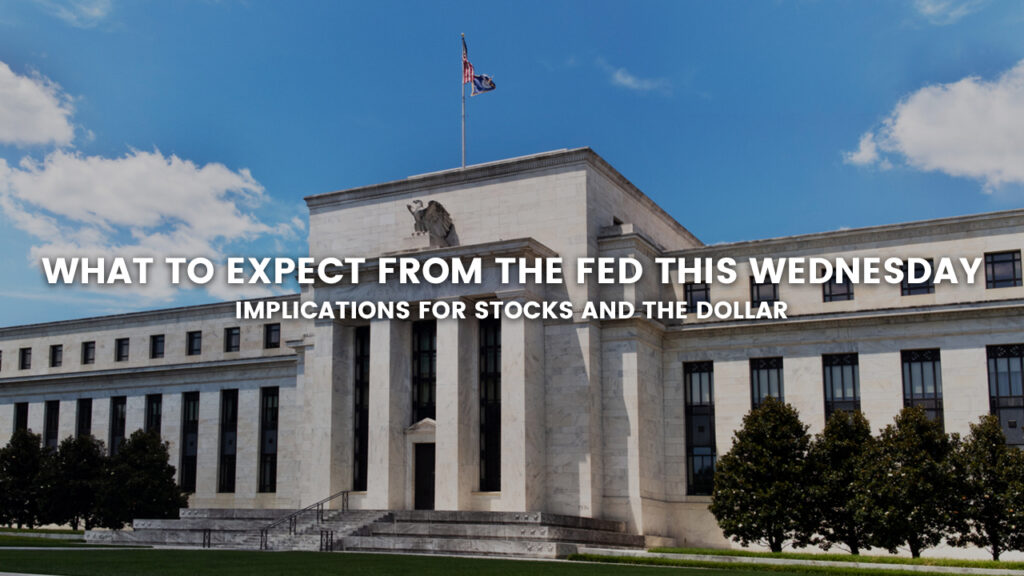What to Expect from the Fed This Wednesday: Implications for Stocks and the Dollar
Article published on January 27th, 2025 9:04AM UK Time

The Federal Open Market Committee (FOMC) is widely expected to maintain its interest rate at 4.375% during Wednesday’s meeting, consistent with a unanimous consensus from a Reuters survey of 103 economists. While a pause in rate hikes seems certain, the meeting’s implications for the stock market and the U.S. dollar (USD) are drawing significant attention in terms of the Fed’s signalling.
The Fed’s Decision and the USD
The U.S. dollar has shown resilience in recent weeks, underpinned by stronger-than-expected U.S. economic data, including robust labor market performance and easing inflation. The Fed’s decision to hold rates this week is unlikely to trigger a negative reaction for the dollar. Markets are operating with a cautious tone ahead of key risks, including the potential imposition of tariffs on Mexico, Canada, and China as the February 1 deadline approaches.
The weekend’s use of tariff threats against Colombia to achieve U.S. policy aims demonstrates the administration’s willingness to use trade measures as a policy tool. This has tempered volatility in currency markets but remains a significant factor for USD movement. While the FOMC meeting itself is expected to be neutral for the dollar, attention will quickly shift to Friday’s core PCE inflation data, where a lower than expected reading could reduce inflation fears and push market pricing for Fed rate cuts further toward 50bps by year-end.
Stocks in Focus: Tech Earnings and Market Sentiment
U.S. equity markets are set for a pivotal week as several major tech firms report their fourth-quarter earnings.Apple’s earnings are on Thursday, Meta and Tesla’s earnings are on Wednesday. Surprises in tech earnings could weigh on sentiment, especially if earnings results fail to justify elevated valuations.
A stable Fed decision could provide some support for equities, but much will depend on the broader macroeconomic context, including Friday’s inflation reading. Cooling inflation could reignite optimism for a slower Fed easing cycle, which would be a net positive for growth-oriented sectors like tech.
Market Expectations for the Fed
Although a rate hold is the base case, markets are already looking ahead to the Fed’s March meeting, where a 25bps cut is anticipated by 61 of the 103 economists surveyed by Reuters. However, money markets remain cautious, pricing in only about 10bps of easing in March.
For the rest of the year, money markets are pricing in around 40bps of easing, implying a 60% likelihood of a second rate cut by year-end. This aligns with the Fed’s projections, which suggest the federal funds rate could end 2025 at 3.9%.
On the economic front, Trump has highlighted plans to stabilize energy markets by both tapping U.S. domestic oil resources and pressuring OPEC to lower prices. Lower oil prices would reduce inflationary pressures globally, cut costs for energy-intensive industries, and boost consumer spending. These measures would be particularly beneficial to equity markets, as reduced energy costs would enhance corporate profitability and disposable income, fueling economic growth.
Inflation Risks and Policy Headwinds
Despite cooling inflation trends, risks remain skewed to the upside. The Fed doesn’t expect core inflation to return to its 2% target until 2027 with a reading of 2.5% for 2025 and 2.2% for 2026, and analysts warn that the administration’s trade policies could reintroduce inflationary pressures. Barclays notes that if the U.S. imposes significant new tariffs, “disinflationary pressures could stall,” potentially delaying Fed rate cuts or forcing the central bank to hold rates for longer.
The Outlook for Wednesday
For equities, a steady Fed decision combined with easing inflation trends could provide a supportive backdrop, particularly for tech stocks facing earnings pressure. For the dollar, the Fed’s cautious stance and strong U.S. data should prevent significant downside in the near term, keeping the focus on Friday’s core PCE inflation reading.
This week’s FOMC decision, coupled with upcoming macro data and tech earnings, will be critical in setting the tone for stocks and the USD as markets navigate a delicate balance of risks and opportunities.
The combined effect of these policies—resolving the Ukraine conflict, improving U.S.-China relations, and stabilizing energy prices—would create a favorable environment for global markets. Equities would likely rally as geopolitical risks recede and inflationary pressures subside. Additionally, improved trade relations with China would bolster investor confidence, while peace in Ukraine would alleviate broader economic uncertainties.
If executed effectively, Trump’s proposed strategies could deliver a rare trifecta: global stability, lower energy costs, and strong market performance. As markets closely monitor the administration’s next steps, the potential for significant economic and geopolitical breakthroughs remains high.